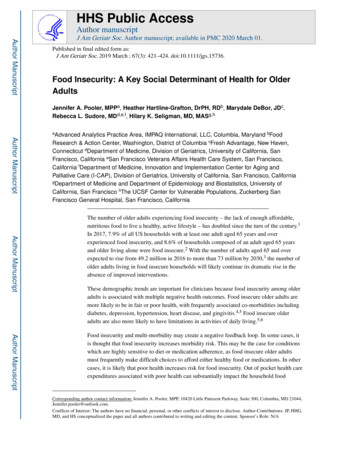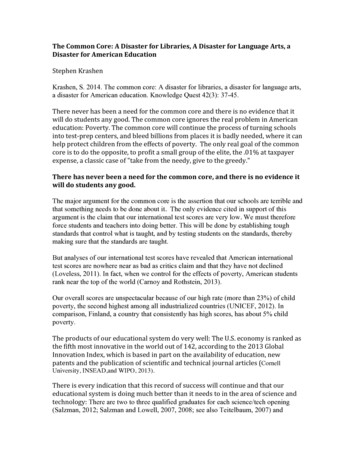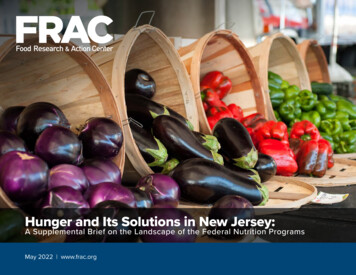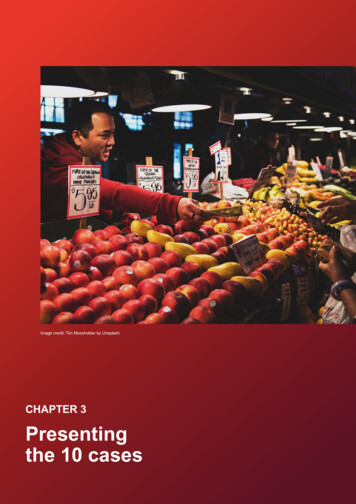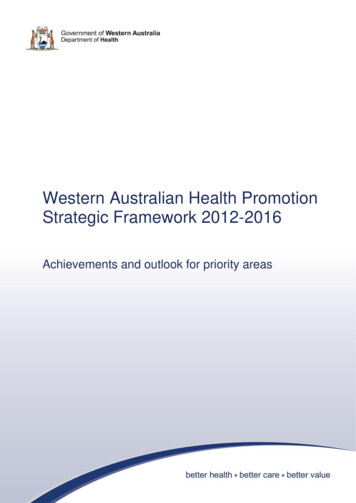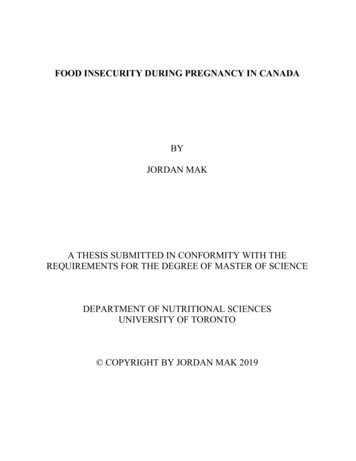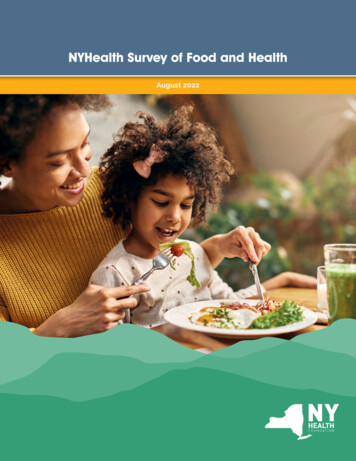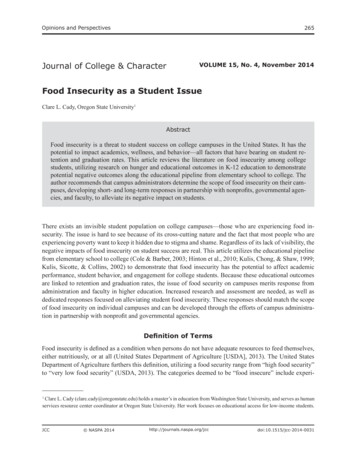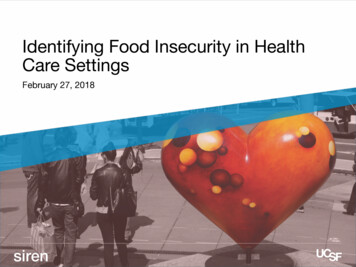
Transcription
Identifying Food Insecurity in HealthCare SettingsFebruary 27, 2018siren
Online resource hubsirenhttp://sirenetwork.ucsf.edu/
Searchable Evidence Librarysirenhttp://sirenetwork.ucsf.edu/
Consultation and CollaborationOpportunitiessiren
Today’s SpeakerssirenCaroline Fichtenberg, PhDManaging DirectorSIRENJacqueline Torres, PhDAssistant ProfessorUCSF Department of Epidemiology &BiostatisticsEmilia De Marchis, MDClinical Fellow Primary Care ResearchUCSF Family & Community MedicineDeepak Palakshappa, MD, MSHPAssistant ProfessorDepartments of Internal Medicine andPediatricsWake Forest School of Medicine
Identifying Food Insecurityin the Health Care Setting:A Review of the LiteratureEmilia De Marchis, MD & Jacqueline Torres, PhD, MPHSIREN WebinarFebruary 27, 2018sirenSocial Interventions Research & Evaluation Network
Disclosures and Acknowledgements Funding provided by Kaiser Foundation Health Plan, Inc Thanks to many for reading early drafts of brief Seth Berkowitz, MD, Alicia Cohen, MD, MSc, Stephanie Ettinger de Cuba, MPH, Megan Sandel, MD, MPH, Rich Sheward, MPP, John Steiner, MD, MPH Holly Wing, MA Stephanie ChernitskysirenSocial Interventions Research & Evaluation Network
Background Food insecurity (FI) linked to health across the life-course Growing interest in screening and acting on patients’ socialdeterminants of health (SDH) Lack of clear guidelines on screening tools & implementation in healthcare settingssirenSocial Interventions Research & Evaluation Network
A Systematic Scoping Review ofFI Screening in the Health Care SettingsirenSocial Interventions Research & Evaluation Network
“Scoping” Review? Inclusive of wide range of content domains and methods Useful for mapping out landscape of emerging research: Clarify boundaries Identify key gaps Still rigorous, replicable!(Colquhoun et al. 2013. J Clin Epidemiol)sirenSocial Interventions Research & Evaluation Network
Brief Methods PubMed and EMBASE/Medline databases Inclusion Criteria: Peer-reviewed research January 2000 – July 2017 FI screening in the health care setting Could be done alongside other SDH screening FI outcomes needed to be specifiedsirenSocial Interventions Research & Evaluation Network
ResultssirenSocial Interventions Research & Evaluation Network
Overview 26 unique articles Study designs: 1 cluster RCT, 2 RCTs, 2 single-group pre-post Multiple qualitative & mixed-methodsirenSocial Interventions Research & Evaluation Network
Overview Multiple domains: 10 measurement 16 implementation 10 patient/provider acceptability 23/26 pediatric or young adult settingssirenSocial Interventions Research & Evaluation Network
Validity of Brief FI Screening Tools 4 studies, 3 different screeners All compared to 18-item USDA-FSSsirenSocial Interventions Research & Evaluation Network
Validity of Brief FI Screening ToolsTwo-Item Hunger* Vital SignTMin Hager et al & Baer et al“Within the past 12 months, we worriedwhether our food would run out before wegot money to buy more.” Often True, Sometimes True, Never True“Within the past 12 months, the food webought just didn't last and we didn't haveenough money to get more.” Often True, Sometimes True, Never TruesirenOne-Item SEEKScreenerin Lane et al“In the last year, did youworry that your foodwould run out beforeyou got money or foodstamps to buy more?” Yes, NoOne-Item Screenerin Kleinman et al“In the past month, wasthere any day when youor anyone went hungrybecause you did nothave enough money forfood?” Yes, NoSocial Interventions Research & Evaluation Network
Validity of Brief FI Screening Tools Hunger Vital SignTM 2-item: 89-97% sensitivity; 83-84% specificity SEEK 1-item: 59% sensitivity; 87% specificity Kleinman et al 1-item: 83% sensitivity, 80% specificitysirenSocial Interventions Research & Evaluation Network
FI Screens vs. Need/Desire for Assistance 3 observational studies, all using Online Advocate tool Bottino et al: 340 caregivers; 6-item USDA50% ofthose withFI asked forfoodreferralssiren50% ofthose askingfor foodreferralswere FISocial Interventions Research & Evaluation Network
FI Screens vs. Need/Desire for Assistance Hassan et al: 401 young adults; Hunger Vital SignTM29% positive for FI17% wantedreferral Wylie et al: 50 young adults; Hunger Vital SignTM34%positivefor FIsiren32%wantedfoodreferralSocial Interventions Research & Evaluation Network
Screening Modality 3 studies: 1 RCT directly comparing methods Gottlieb et al: 538 caregivers in a pediatric ED randomized totablet-based self-administration OR face-to-face. 23-item psychosocial needs questionnaire No differences in FI disclosuresirenSocial Interventions Research & Evaluation Network
Time for Screening 10 articles addressed perceived and actual time burden Range 30 seconds to 10-15 minutes to complete Mixed findings regarding providers’ perceived time burden O’Toole et al: 40 pediatric residents Residents in clinics with more resources to address SDH(e.g. social workers) spent more time on SDH screening(160 sec. versus 37.5 sec. for low resource clinics)sirenSocial Interventions Research & Evaluation Network
Increasing Screening Uptake 7 articles evaluated interventions to improve uptake (all amongpediatric residents) Range of interventions: Training via video, in-person, observations and feedback,visiting food banks and other social servicessirenSocial Interventions Research & Evaluation Network
Increasing Screening Uptake Residents trained on FI/SDH had higher screening rates/selfreported ability to screen Burkhardt et al: 24 pediatric residents Incorporated clinic-wide strategies FI identification increased from 1.0% to 11.9%sirenSocial Interventions Research & Evaluation Network
Patient and Provider Acceptability Overall, patients/caregivers receptive to FI screening Some concern about how results would be used Providers report high acceptability of screening, as long as theyhave access to resources to address identified needs. Providers may feel more comfortable having FI screeningcompleted prior to visitssirenSocial Interventions Research & Evaluation Network
Conclusions Brief FI screening tools validated in health care settings Inconsistent overlap: screening positive vs. wanting food-relatedassistance from the health care setting Limited research on modality Screening can be quick! Training on FI/SDH screening can improve uptake Patients/caregivers open to screening, especially when explained Providers open to screening, especially with training andresourcessirenSocial Interventions Research & Evaluation Network
Please visitsirenetwork.ucsf.edufor full issue briefsirenSocial Interventions Research & Evaluation Network
Screening for Food Insecurity inSuburban Primary Care PracticeSIREN WebinarFebruary 27, 2018
Food Insecurity in Practice Most food insecurity studies have focusedon urban practices Less is known about the feasibility &acceptability of screening in other areasGarg, 2007; Garg 2015; Burkhardt 2012; Beck 2016; Gottlieb, 2016; DeJong 2016; Palakshappa 2016Wake Forest Baptist Medical Center
The Rapid Rise of Suburban PovertyPoor Population in Cities and Suburbs, 95 Large Metro Areas, 1970 to 8.387.466.410.48.47.1420197019801990Year2000Used with permission from BROOKINGS INSTITUTION ANALYSIS OF DECENNIAL CENSUS ANDAMERICAN COMMUNITY SURVEY2012
ObjectiveDetermine the feasibility and acceptability ofscreening for food insecurity in suburban primarycare practicesWake Forest Baptist Medical Center
Study Design & Setting Design: Prospective mixed methods study 2, 15, and 36-month well child visits Setting: 6 suburban pediatric practicesWake Forest Baptist Medical Center
Wake Forest Baptist Medical Center
Outcome Measures Feasibility: Number of families eligible for screen Number screened Results of the screenWake Forest Baptist Medical Center
Outcome Measures Acceptability:1. Perceptions of screening2. Interactions with parents and clinicians3. Suggestions for improvement Focus groups of clinicians at each site Semi-structured interviews with parents offood insecure childrenWake Forest Baptist Medical Center
5,648 Eligible4371 (77.4%)Families screened122 (2.8%)Positive screen
Clinicians1. Embarrassing families and providing adequate resources were barriers“Oh, I think it works fine with flow. I think peopleare still like, ‘Oh, I don’t know if I want to ask thisquestion. Am I going to embarrass them.”Wake Forest Baptist Medical Center
Clinicians1. Embarrassing families and providing adequate resources were barriers“Oh, I think it works fine with flow. I think people are still like, ‘Oh, I don’t know if I want toask this question. Am I going to embarrass them.”2. Screening showed caring which reinforced clinicians continued screening“I do think it sent a message to the patients thatyou care about this social issue.”Wake Forest Baptist Medical Center
Clinicians1. Embarrassing families and providing adequate resources were barriers“Oh, I think it works fine with flow. I think people are still like, ‘Oh, I don’t know if I want toask this question. Am I going to embarrass them.”2. Screening showed caring which reinforced clinicians continued screening“I do think it sent a message to the patients that you care about this social issue.”3. Screening prior to the visit“[it would be better if] it was something thatgetting screened for before we even set foot in theroom. If they screen negative great. If they screenpositive, then we would get a flag or something.”Wake Forest Baptist Medical Center
Parents1. Initially surprised, but ultimately felt comfortable discussing food insecurity“-it was kinda weird, I guess. I wasn’t expecting it.But at the same time, it would be helpful to peopleif they are honest.”Wake Forest Baptist Medical Center
Parents1. Initially surprised, but ultimately felt comfortable discussing food insecurity“-it was kinda weird, I guess. I wasn’t expecting it. But at the same time, it would be helpfulto people if they are honest.”2. Parents experience shame and helplessness regarding food insecurity, but discussingwith their clinician helps alleviate these feelings“I was a little shocked because usually they don’task that. It gave me an opportunity to saysomething to somebody who might be able tohelp.”Wake Forest Baptist Medical Center
Parents1. Initially surprised, but ultimately felt comfortable discussing food insecurity“-it was kinda weird, I guess. I wasn’t expecting it. But at the same time, it would be helpfulto people if they are honest.”2. Parents experience shame and helplessness regarding food insecurity, but discussingwith their clinician helps alleviate these feelings“I was a little shocked because usually they don’t ask that. It gave me an opportunity to saysomething to somebody who might be able to help.”3. Parents felt information about local resources would be most helpful“I personally think they could have more options ofwhere to go if they are having trouble Especially ifthey can’t qualify for food stamps or something likethat.”Wake Forest Baptist Medical Center
Feasible to screen in suburban practices 77% of families who were eligible werescreened 2.8% of families food insecure (0.9-5.9%across clinics)Wake Forest Baptist Medical Center
Feasible to screen 77% of families who were eligible werescreened 2.8% of families were food insecure (0.9-5.9%across clinics) Acceptable to screen Did not interfere with time or workflow Parents felt it showed the clinic cared Screen prior to the visit and connect familiesto local resourcesWake Forest Baptist Medical Center
Acknowledgements Alexander Fiks Chris Feudtner Stephanie Doupnik Saba Khan Leah Seifu Aditi VasanWake Forest Baptist Medical Center18
QuestionsWake Forest Baptist Medical Center
Connecting with sirenetwork.ucsf.edusiren@ucsf.edu@SIREN UCSFSocial Interventions Research &Evaluation Network@SIRENetwork
Wake Forest Baptist Medical Center Food Insecurity in Practice Most food insecurity studies have focused on urban practices Less is known about the feasibility & acceptabilityof screening in other areas Garg, 2007; Garg 2015; Burkhardt 2012; Beck 2016; Gottlieb, 2016; DeJong2016; Palakshappa2016

